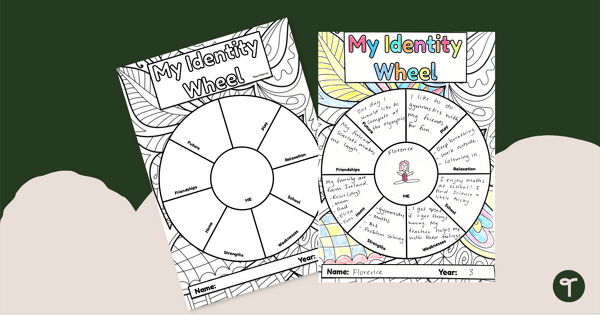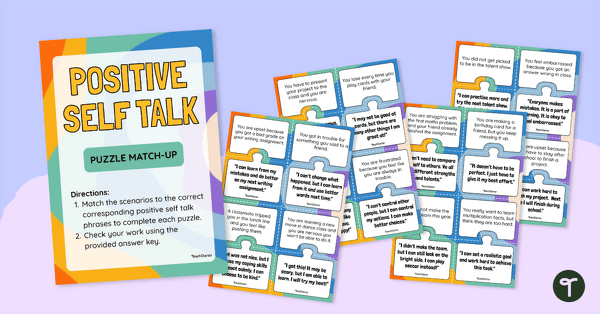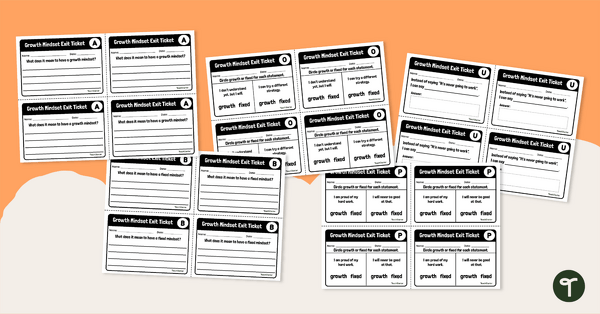Strengths and Weaknesses Teaching Resources
Are you teaching students to identify their strengths and weaknesses (or maybe you call them strengths and challenges?) this school year? Explore SEL activities, worksheets and more teacher resources created by teachers to help you prepare your students to be more self-reflective and set goals that are realistic.
This collection of teacher resources has been designed to build upon the self awareness competency in the SEL curriculum, providing your students with skills they'll need to take ownership of their learning journey in the classroom and beyond.
Teaching this section of social emotional learning for the first time this school year, or maybe you're just looking for fresh ideas? Read on for a primer from our teacher team, including strengths and weaknesses examples to use with your students.
Why Do We Teach Strengths and Weaknesses?
Teaching our students to be able to identify their own strengths and weaknesses is an important part of helping kids to develop their emotional intelligence and build their self-confidence.
Consider what happens when a child recognises that they're doing well at something. It's a powerful motivator for our students, helping them gain confidence to tackle more challenges.
On the other hand, being able to recognise areas where they need to work to improve can also be motivating as it gives kids the ability to set goals and work toward them.
This self awareness will have long-term benefits for all students!
How to Teach Kids to Identify Their Own Strengths and Weaknesses
We've pretty well established it's important ... but how do you actually teach this? In addition to the teacher resources you'll find in this collection, our teacher team has put together this guide to help you plan your lessons!
- Use Self-Assessment Tools — You'll notice this collection has age-appropriate self-assessment tools that we've created to help students evaluate their own progress. That's
- Provide Opportunities for Self Reflection — Learning to reflect is something that takes a lot of practice. Make a point of providing those opportunities in your classroom. You may ask your students direct questions when working with them individually — such as 'What did you do well in this activity, and why?' — or you may provide thought-provoking prompts for students to answer in their journals.
- Celebrate Strengths as a Whole Class — It's important for students to see strengths not just in themselves but in their peers. Encourage your students to not just identify but also celebrate each other's strengths! In this type of positive and supportive classroom environment, students often to learn from and inspire one another.
- Explore Multiple Intelligences — We all have our own individual strengths and challenges, and our students should learn that is absolutely normal and OK! Introduce the concept of multiple intelligences to your students and explain that people have different strengths in various areas. One student may be a whiz at maths mentals. Another student may excel on the rugby field or in art class. Talking about different people's different strengths can help your students understand that they don't have to be the best at everything. It is also a good way to help them see that being good at one thing doesn't mean they can't excel in other domains.
- Make Sure Your Feedback is Constructive — This may sound obvious, but providing constructive feedback to our students about their work, emphasising both their strengths and areas for improvement, is a way for kids to learn that feedback is an opportunity for growth.
What Are Examples of Strengths and Weaknesses in a Student?
Of course, presenting the concept of 'strengths' and 'weaknesses' to a classroom full of kids can have its own challenges. No one likes being labeled as 'weak,' and that includes primary school students!
It can be especially fraught for high-achieving students who get easily frustrated when they face challenges they aren't accustomed to facing. Likewise, struggling learners may find discussing their challenges to be yet another reminder that they're not doing exactly what their peers are doing.
We've found it's helpful to brainstorm examples of each as a class to help kids start to see that these terms are not nearly as loaded as they might sound. It can also be a helpful way to explore the diversity of strengths and weaknesses that we all have — so students understand that this is not simply about the numbers on their report cards.
Starting that discussion in your classroom? Here are some examples of strengths and weaknesses that are common for children and that can help kick-start your classroom brainstorm!
Strengths Examples
- Demonstrates good listening skills during class instructions
- Displays creativity in arts and crafts activities
- Shows curiosity and asks interesting questions during instruction
- Shows leadership qualities when working in small groups
- Has good time management skills
Weaknesses Examples
- Struggles with long division
- Finds it challenging to sit still for long periods of time
- Struggles with public speaking or presenting in front of the class
- Has difficulty organising ideas for written assignments
- Needs to be reminded to stay focused during classroom activities
- Plus Plan

I Am Worksheet - Affirmation Art Activity
Use this ‘I Am’ Worksheet to inspire your students to share how special they are at the beginning of the school year.
- Plus Plan

Growth Mindset Bookmarks
Encourage your students to think about their growth mindset with this set of printable bookmarks.
- Free Plan

Personal Identity Activity (My Identity Wheel)
Explore personal identity by completing this personal identity wheel template.
- Free Plan

Personal Qualities Word Search
Explore different personal qualities with your students with this printable personal qualities word search.
- Plus Plan

Exploring My Strengths Worksheet
Explore individual strengths with this My Strengths Worksheet.
- Plus Plan

Growth or Fixed Mindset Sorting Activity
Help students understand the difference between a fixed mindset and a growth mindset with this sorting activity.
- Free Plan

Self-Esteem Heart Activity
Help students boost their self-esteem with this lovely heart-themed activity
- Plus Plan

Parts of My Identity Flipbook
Explore personal identity with your students with this Parts of Me Identity Flipbook.
- Plus Plan

Building Self-Esteem Worksheet
Explore everything there is to know about self-esteem with your students using this cloze worksheet.
- Plus Plan

My Personal Identity Teaching Slides (What Makes Me Me?)
Explore what makes each student an individual and help them explore their own identity with this set of teaching slides.
- Plus Plan

Let's Look at Self Esteem Interactive Activity
Boost your students' self-esteem with this fun and engaging interactive activity.
- Free Plan

Personal Strengths Paper Chains
Explore your individual strengths with this fun paper chain activity.
- Plus Plan

Growth Mindset Interactive Activity
Engage students in spending time looking at how to grow their growth mindset with this interactive activity.
- Plus Plan

Growth Mindset Mini-Book
Teach your students about growth mindset with this printable book, perfect for your social emotional lessons!
- Plus Plan

Growth Mindset Discussion Cards
Explore growth mindset with your students with this set of discussion cards.
- Plus Plan

My Accomplishments Worksheets
Celebrate your students' achievements and accomplishments with these self-esteem boosting worksheets!
- Plus Plan

'Why I'm AMAZING' Self-Esteem Templates
Boost students' self-esteem with these Reasons Why I'm AMAZING templates.
- Plus Plan

Self-Esteem Builder Board Game
Explore how to build self-esteem with your students using this fun self-esteem game board.
- Plus Plan

Building Confidence Worksheet
Give students an opportunity to brainstorm ways they can be an advocate for themselves and others with this building confidence worksheet.
- Plus Plan

Positive Self Talk Match-Up
Teach your students how positive self talk in challenging situations can boost self-esteem with this match-up activity.
- Plus Plan

Proud to be Me Scoot Game
Engage students in identifying and describing personal identity while also promoting discussion with this active activity.
- Plus Plan

Growth Mindset Exit Tickets
Assess your student's understanding of everything growth mindset with this set of exit tickets.
- Plus Plan

Road to High Self-Esteem Board Game
Help students understand what self-esteem is and how to boost their own self-esteem with this board game.
- Plus Plan

Self-Esteem Activity Mini-Book
Build up your student's self-esteem with this activity mini book template.
- Plus Plan

The Power of YET Poster Set
Encourage your students to change their growth mindset with this set of posters.
- Plus Plan

Self -Esteem Flipbook
Explore the topic of self-esteem with your students using this engaging flipbook template.
- Plus Plan

Growth Mindset Flipbook
Explore the topic of growing your mindset with your students using this engaging flipbook template.
- Plus Plan

Growth Mindset Game Show Interactive Activity
Explore growth mindset with this interactive activity that encourages students to think, act, write, talk and decide on true or false for a set of questions.
- Plus Plan

Ways to Build Self-Esteem Classroom Poster
Nurture your students by providing them with simple ways to build up their self-esteem with this set of classroom posters.
- Plus Plan

Personality And Values Activity (Personality Islands Project)
Explore your students’ personalities and values with this fun personality island project.
- Plus Plan

Growing GRIT Writing Template
Encourage students to think about what grit is as well as words that describe grit with this craft template.
- Free Plan

My Self-Esteem Review Template
Help students reflect on their own self esteem with this self-esteem rating template.